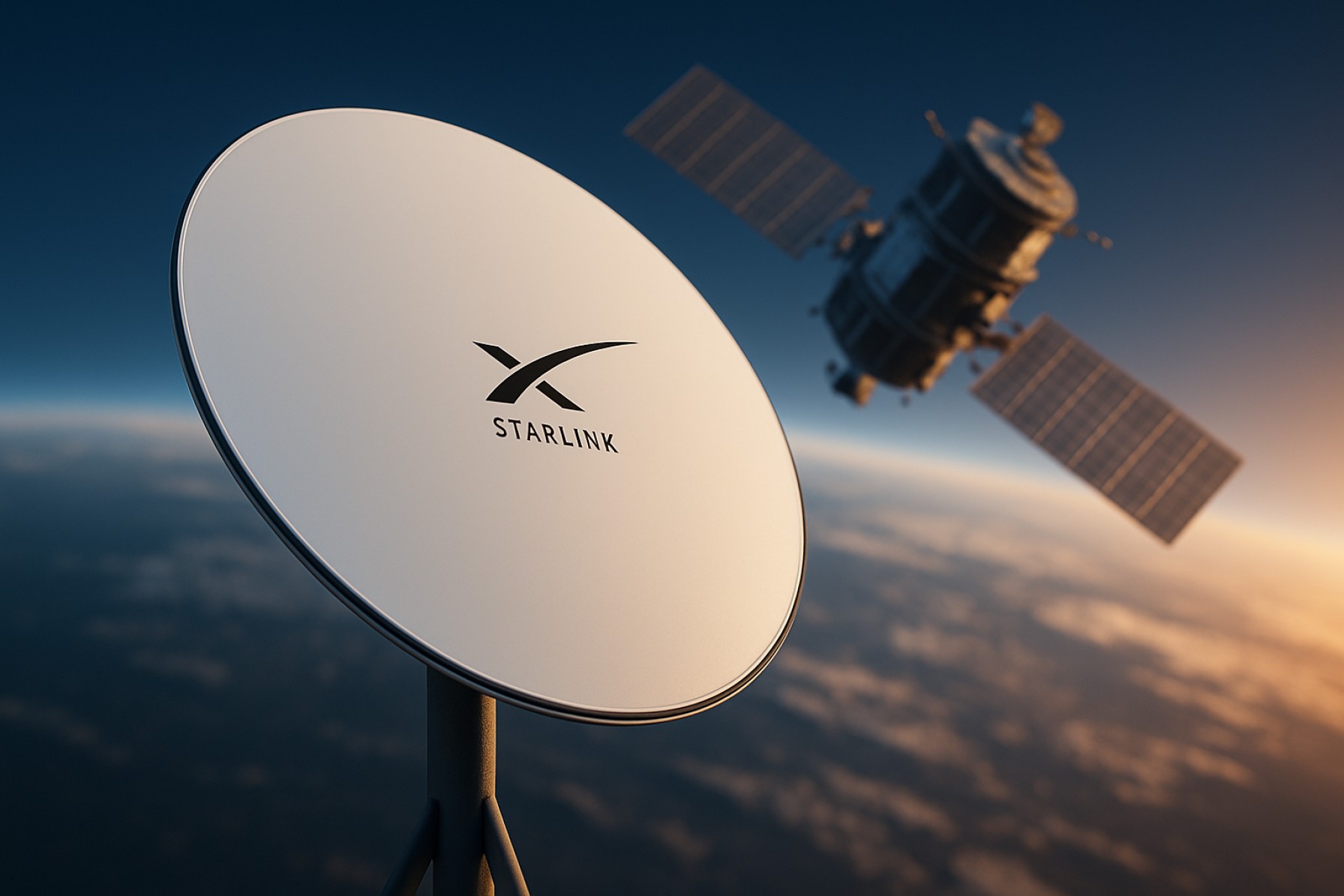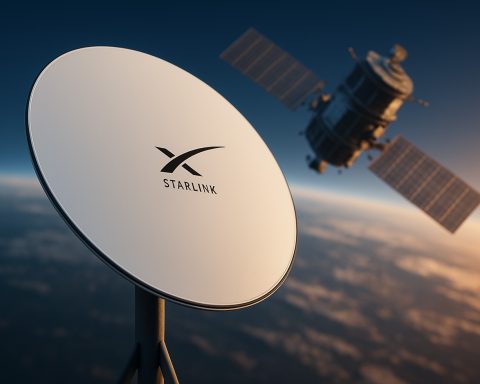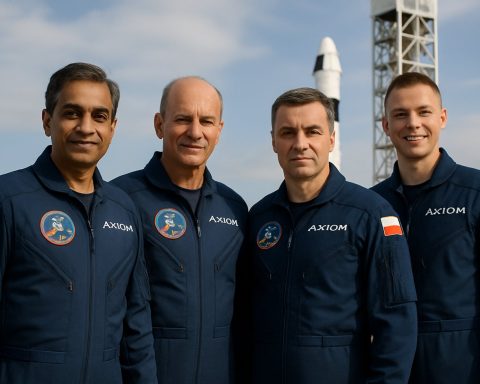Starlink and the Satellite Internet Revolution: Market Dynamics, Disruptors, and Strategic Insights
- Market Overview
- Emerging Technology Trends
- Competitive Landscape and Key Players
- Growth Forecasts and Market Projections
- Regional Analysis and Market Penetration
- Future Outlook and Strategic Implications
- Challenges and Opportunities Ahead
- Sources & References
“Business Model: Starlink is SpaceX’s satellite internet venture aiming to deliver broadband globally using a low Earth orbit (LEO) satellite constellation.” (source)
Market Overview
The satellite internet market is undergoing rapid transformation, with Starlink—SpaceX’s satellite broadband service—emerging as a dominant force. As of early 2024, Starlink operates over 5,500 low-Earth orbit (LEO) satellites, providing high-speed internet to more than 2.6 million subscribers across 70+ countries (CNBC). The company’s aggressive expansion and technological advancements are reshaping the competitive landscape and driving growth in the global satellite internet market.
According to MarketsandMarkets, the global satellite internet market is projected to reach $18.5 billion by 2025, up from $4.8 billion in 2020, representing a compound annual growth rate (CAGR) of 29.5%. This surge is fueled by increasing demand for connectivity in remote and underserved regions, the proliferation of IoT devices, and the need for reliable broadband in disaster recovery and mobility applications.
- Starlink’s Market Share: Starlink is estimated to hold over 50% of the LEO satellite broadband market by 2025, outpacing competitors such as OneWeb and Amazon’s Project Kuiper (Analysys Mason).
- Service Performance: Starlink’s median download speeds now exceed 100 Mbps in many regions, with latency as low as 25 ms, making it competitive with terrestrial broadband (Speedtest by Ookla).
- Pricing and Accessibility: Starlink’s standard residential service is priced at $120/month in the U.S., with hardware costs around $599. The company is also piloting lower-cost options and community access programs in developing markets (Reuters).
While Starlink leads in scale and performance, the market remains dynamic. Regulatory challenges, spectrum allocation, and competition from geostationary (GEO) and medium-Earth orbit (MEO) providers continue to shape the industry. As 2025 approaches, Starlink’s ongoing satellite launches and service innovations are expected to further expand its footprint and influence, solidifying its role as a catalyst in the global satellite internet market.
Emerging Technology Trends
Starlink and the Satellite Internet Market (2025) – Comprehensive Report
As of 2025, the satellite internet market is undergoing rapid transformation, with Starlink—SpaceX’s satellite broadband service—at the forefront. Starlink’s constellation of over 5,000 low-Earth orbit (LEO) satellites now delivers high-speed, low-latency internet to more than 2.5 million subscribers globally, according to CNBC. This expansion is reshaping connectivity, especially in rural and underserved regions where traditional broadband infrastructure is lacking.
- Market Growth: The global satellite internet market is projected to reach $18.5 billion by 2025, up from $8.2 billion in 2021, with a compound annual growth rate (CAGR) of 23.4%.
- Key Players: While Starlink leads, competitors such as OneWeb, Amazon’s Project Kuiper, and Telesat are accelerating their own LEO satellite deployments, intensifying competition and driving innovation.
- Performance: Starlink’s average download speeds now exceed 100 Mbps in most serviced areas, with latency as low as 25 ms, rivaling terrestrial broadband (Speedtest Global Index).
- Affordability: In 2024, Starlink reduced its hardware costs to $299 and monthly service fees to $90 in the U.S., making it more accessible (PCMag).
- Regulatory and Expansion Challenges: Starlink faces regulatory hurdles in markets like India and parts of Africa, but continues to expand coverage, aiming for global reach by late 2025 (Reuters).
Starlink’s impact extends beyond consumer broadband. The service is being adopted for maritime, aviation, and emergency response applications, further broadening its market potential. As satellite internet technology matures, analysts expect increased competition to drive down costs and improve service quality, making high-speed internet accessible to billions more worldwide (McKinsey).
Competitive Landscape and Key Players
The satellite internet market is undergoing rapid transformation, with Starlink—SpaceX’s satellite broadband service—emerging as a dominant force. As of early 2025, Starlink operates the world’s largest low Earth orbit (LEO) satellite constellation, with over 5,500 satellites in orbit and plans to expand to 12,000 by 2027 (SpaceX Updates). This aggressive deployment has enabled Starlink to offer high-speed, low-latency internet to more than 2.5 million subscribers across 70+ countries (CNBC).
Starlink’s competitive edge lies in its global reach, rapid scalability, and continuous technological upgrades. The company’s latest “V2 Mini” satellites, launched in 2024, deliver improved bandwidth and coverage, supporting speeds up to 220 Mbps and latency as low as 25 ms (PCMag). Starlink’s pricing strategy—$120/month for residential service in the U.S. as of Q1 2025—remains competitive, especially in underserved and rural markets where alternatives are limited (Starlink).
Despite Starlink’s dominance, the satellite internet market is increasingly crowded. Key competitors include:
- OneWeb: Backed by Eutelsat, OneWeb operates over 600 LEO satellites, focusing on enterprise, government, and remote connectivity. The company aims to reach global coverage by late 2025 (BBC).
- Amazon Project Kuiper: With its first launches in 2024, Project Kuiper plans to deploy 3,236 LEO satellites by 2027, targeting both consumer and commercial markets (Reuters).
- Viasat and HughesNet: These established GEO satellite providers are upgrading networks and launching new satellites (e.g., Viasat-3) to improve speeds and reduce latency (Fierce Wireless).
As the market matures, competition is expected to intensify, with Starlink leveraging its first-mover advantage and scale, while rivals focus on niche markets, regulatory partnerships, and differentiated service offerings. The satellite internet sector is projected to reach $30 billion in annual revenue by 2027, with LEO constellations accounting for the majority of growth (Mordor Intelligence).
Growth Forecasts and Market Projections
The satellite internet market is undergoing rapid transformation, with Starlink—SpaceX’s low Earth orbit (LEO) satellite constellation—at the forefront of this evolution. As of early 2024, Starlink has deployed over 5,000 satellites and serves more than 2.6 million subscribers globally (CNBC). This momentum is expected to accelerate through 2025, driven by expanding coverage, improved bandwidth, and growing demand for high-speed connectivity in underserved regions.
According to a recent MarketsandMarkets report, the global satellite internet market is projected to reach $18.5 billion by 2025, up from $8.2 billion in 2021, representing a compound annual growth rate (CAGR) of 23.6%. Starlink is anticipated to capture a significant share of this growth, leveraging its first-mover advantage and aggressive satellite deployment strategy.
- Subscriber Growth: Projections suggest Starlink could surpass 4 million subscribers by the end of 2025, especially as it expands into new markets in Asia, Africa, and Latin America (Analysys Mason).
- Revenue Expansion: Starlink’s annual revenue is forecasted to exceed $4.5 billion in 2025, fueled by both residential and enterprise adoption (Bloomberg).
- Market Penetration: The satellite internet sector is expected to serve over 10 million users worldwide by 2025, with LEO constellations like Starlink accounting for more than 60% of new connections (NSR).
- Competitive Landscape: While Starlink leads, competitors such as Amazon’s Project Kuiper and OneWeb are accelerating their own launches, intensifying market competition and driving innovation (Reuters).
In summary, 2025 is poised to be a pivotal year for Starlink and the broader satellite internet market. With robust subscriber growth, expanding global reach, and increasing competition, the sector is set for substantial expansion, reshaping digital connectivity for remote and rural communities worldwide.
Regional Analysis and Market Penetration
Starlink and the Satellite Internet Market (2025) – Comprehensive Report
As of 2025, Starlink, a subsidiary of SpaceX, continues to dominate the global satellite internet market, leveraging its extensive low Earth orbit (LEO) satellite constellation. The company’s aggressive deployment strategy has resulted in over 5,000 operational satellites, providing coverage to more than 70 countries and serving an estimated 3 million subscribers worldwide (SpaceX Updates). This rapid expansion has positioned Starlink as a key disruptor in both developed and emerging markets.
- North America: Starlink’s penetration in the United States and Canada remains robust, with rural and underserved regions experiencing significant improvements in broadband access. The Federal Communications Commission (FCC) reports that Starlink now covers over 90% of rural households lacking high-speed internet, contributing to a narrowing of the digital divide (FCC 2025 Broadband Deployment Report).
- Europe: Regulatory approvals and partnerships with local ISPs have enabled Starlink to expand rapidly across Western and Eastern Europe. The European Commission notes a 40% year-over-year increase in satellite broadband subscriptions, with Starlink accounting for the majority share (European Commission: Broadband Europe).
- Asia-Pacific: Starlink’s entry into markets such as India, Indonesia, and the Philippines has been met with strong demand, particularly in remote and island communities. The Asia-Pacific satellite internet market is projected to grow at a CAGR of 18% through 2028, with Starlink leading the segment (Mordor Intelligence: Asia-Pacific Satellite Internet Market).
- Latin America and Africa: Starlink’s affordable pricing and simplified installation have driven adoption in regions with limited terrestrial infrastructure. In Brazil and Nigeria, for example, Starlink’s subscriber base doubled in 2024, and the company is now the fastest-growing satellite ISP in both regions (Statista: Starlink Subscribers by Country).
Despite increasing competition from OneWeb, Amazon’s Project Kuiper, and regional players, Starlink’s first-mover advantage, global reach, and ongoing satellite launches are expected to sustain its market leadership through 2025 and beyond.
Future Outlook and Strategic Implications
The satellite internet market is poised for significant transformation in 2025, with Starlink, SpaceX’s satellite broadband service, at the forefront of this evolution. As of early 2024, Starlink operates over 5,500 satellites in low Earth orbit (LEO), serving more than 2.6 million customers globally (CNBC). This rapid expansion is reshaping the competitive landscape and setting new benchmarks for speed, latency, and coverage in the satellite internet sector.
Market Growth and Projections
- The global satellite internet market is projected to reach $18.59 billion by 2025, growing at a CAGR of 13.6% from 2023 (MarketsandMarkets).
- Starlink’s aggressive deployment strategy aims to increase its satellite constellation to over 12,000 by 2027, further enhancing capacity and global reach (SpaceX Updates).
- Emerging markets in Africa, Southeast Asia, and Latin America are expected to drive subscriber growth, as Starlink and competitors address connectivity gaps in underserved regions.
Strategic Implications
- Competitive Dynamics: Starlink’s scale and first-mover advantage are pressuring legacy providers such as Viasat and HughesNet to innovate and lower prices. New entrants like Amazon’s Project Kuiper are also intensifying competition (Reuters).
- Regulatory Considerations: As Starlink expands, regulatory scrutiny over spectrum allocation, orbital debris, and national security is increasing. Governments are developing new frameworks to manage LEO satellite proliferation (ITU).
- Technological Advancements: Starlink’s ongoing upgrades, including inter-satellite laser links and improved ground terminals, are expected to further reduce latency and boost throughput, making satellite internet more competitive with terrestrial broadband (Starlink Technology).
- Strategic Partnerships: Collaborations with telecom operators, governments, and enterprise customers are expanding Starlink’s addressable market, particularly in remote education, disaster response, and maritime connectivity.
In summary, Starlink’s trajectory in 2025 will likely accelerate the democratization of high-speed internet access worldwide, disrupt traditional telecom models, and catalyze new regulatory and technological paradigms in the satellite internet market.
Challenges and Opportunities Ahead
The satellite internet market is undergoing rapid transformation, with Starlink, a subsidiary of SpaceX, at the forefront of this evolution. As of 2025, Starlink operates a constellation of over 5,000 low-Earth orbit (LEO) satellites, providing broadband internet to more than 2.5 million subscribers globally (CNBC). This expansion has positioned Starlink as a dominant player, but the sector faces both significant challenges and promising opportunities.
-
Challenges:
- Regulatory Hurdles: Starlink must navigate complex international regulations, including spectrum allocation and licensing, which vary by country. For example, India and several African nations have delayed or restricted Starlink’s entry due to regulatory concerns (Reuters).
- Competition: The market is becoming increasingly crowded, with Amazon’s Project Kuiper, OneWeb, and China’s Guowang constellation all planning to launch thousands of satellites by 2025 (Bloomberg). This intensifies the race for market share and technological superiority.
- Cost and Affordability: While Starlink has reduced hardware costs to around $299 per terminal, monthly fees remain high for many users in developing regions, limiting adoption (The Verge).
- Space Debris and Sustainability: The proliferation of LEO satellites raises concerns about space debris and long-term orbital sustainability, prompting calls for stricter international guidelines (Nature).
-
Opportunities:
- Expanding Rural Connectivity: Starlink’s technology is uniquely positioned to bridge the digital divide in underserved and remote areas, supporting education, healthcare, and economic development (World Bank).
- Enterprise and Government Markets: Starlink is expanding into maritime, aviation, and defense sectors, offering high-speed connectivity for ships, aircraft, and military operations (Defense News).
- Technological Innovation: Advances in phased-array antennas, laser inter-satellite links, and AI-driven network management are expected to improve performance and reduce latency, enhancing Starlink’s competitive edge (MIT Technology Review).
In summary, while Starlink faces regulatory, competitive, and sustainability challenges, its innovative approach and expanding service portfolio present substantial opportunities for growth in the global satellite internet market in 2025 and beyond.
Sources & References
- Starlink and the Satellite Internet Market (2025) – Comprehensive Report
- Starlink Technology
- CNBC
- MarketsandMarkets
- Amazon Project Kuiper
- Analysys Mason
- Speedtest Global Index
- Telesat
- McKinsey
- BBC
- Fierce Wireless
- Mordor Intelligence: Asia-Pacific Satellite Internet Market
- NSR
- European Commission: Broadband Europe
- Statista: Starlink Subscribers by Country
- ITU
- The Verge
- Nature
- World Bank
- Defense News
- MIT Technology Review











